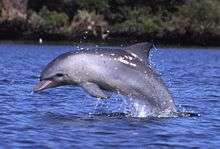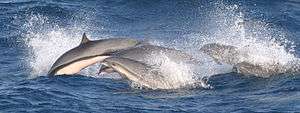List of mammals of Madagascar
This is a list of the native wild mammal species recorded in Madagascar. As of June 2014 (following the IUCN reassessment of the lemurs) there are 241 extant mammal species recognized in Madagascar, of which 22 are critically endangered, 62 are endangered, 32 are vulnerable, 9 are near-threatened, 72 are of least concern and 44 are either data deficient or not evaluated. All of the critically endangered species are lemurs. Most if not all of the 29 listed extinct species are believed to have died out in prehistoric times, following the first appearance of humans about 2000 years ago; none of these are known to have survived into the post-European contact period.[n 1]
The mammalian fauna of Madagascar is highly distinctive and largely endemic. The extant nonmarine, nonchiropteran taxa constitute (as of June 2014) 168 species, 40 genera and 9 families; of these, endemic forms make up all but perhaps one of the species,[n 2] all but one genus,[n 3] and all but three of the families.[n 4]
The following tags are used to highlight each species' conservation status as assessed by the IUCN:
| EX | Extinct | No reasonable doubt that the last individual has died. |
| EW | Extinct in the Wild | Known only to survive in captivity or as a naturalized population well outside its historic range. |
| CR | Critically Endangered | The species is in imminent danger of extinction in the wild. |
| EN | Endangered | The species is facing a very high risk of extinction in the wild. |
| VU | Vulnerable | The species is facing a high risk of extinction in the wild. |
| NT | Near Threatened | The species does not qualify as being at high risk of extinction but is likely to do so in the future. |
| LC | Least Concern | The species is not currently at risk of extinction in the wild. |
| DD | Data Deficient | There is inadequate information to assess the risk of extinction for this species. |
| NE | Not Evaluated | The conservation status of the species has not been studied. |
Subclass: Theria
Infraclass: Eutheria
Superorder Afrotheria
Order: Afrosoricida (tenrecs and golden moles)
The afrotherian order Afrosoricida contains the golden moles of southern Africa and the tenrecs of Madagascar and Africa, two families of small mammals that were traditionally part of the order Insectivora. All the native tenrecs of Madagascar are believed to descend from a common ancestor that arrived 25–42 million years ago after rafting over from Africa[7][8] (where only 3 species of tenrecids, the otter shrews, survive).
- Family: Tenrecidae (tenrecs)
- Subfamily: Geogalinae
- Genus: Geogale
- Large-eared tenrec Geogale aurita LC
- Genus: Geogale
- Subfamily: Oryzorictinae
- Genus: Limnogale
- Web-footed tenrec Limnogale mergulus VU
- Genus: Microgale
- Short-tailed shrew tenrec Microgale brevicaudata LC
- Cowan's shrew tenrec Microgale cowani LC
- Dobson's shrew tenrec Microgale dobsoni LC
- Drouhard's shrew tenrec Microgale drouhardi LC
- Dryad shrew tenrec Microgale dryas VU
- Pale shrew tenrec Microgale fotsifotsy LC
- Gracile shrew tenrec Microgale gracilis LC
- Microgale grandidieri
- Naked-nosed shrew tenrec Microgale gymnorhyncha LC
- Jenkins' shrew tenrec Microgale jenkinsae EN
- Northern shrew tenrec Microgale jobihely EN
- Lesser long-tailed shrew tenrec Microgale longicaudata LC
- Microgale macpheei EX (PH)
- Major's long-tailed tenrec (Microgale majori) LC
- Montane shrew tenrec Microgale monticola VU
- Nasolo's shrew tenrec Microgale nasoloi VU
- Pygmy shrew tenrec Microgale parvula LC
- Greater long-tailed shrew tenrec Microgale principula LC
- Least shrew tenrec Microgale pusilla LC
- Shrew-toothed shrew tenrec Microgale soricoides LC
- Taiva shrew tenrec Microgale taiva LC
- Talazac's shrew tenrec Microgale talazaci LC
- Thomas's shrew tenrec Microgale thomasi LC
- Genus: Oryzorictes
- Mole-like rice tenrec Oryzorictes hova LC
- Four-toed rice tenrec Oryzorictes teradactylus DD
- Genus: Limnogale
- Subfamily: Tenrecinae
- Genus: Echinops
- Lesser hedgehog tenrec Echinops telfairi LC
- Genus: Hemicentetes
- Highland streaked tenrec Hemicentetes nigriceps LC
- Lowland streaked tenrec Hemicentetes semispinosus LC
- Genus: Setifer
- Greater hedgehog tenrec Setifer setosus LC
- Genus: Tenrec
- Tailless tenrec Tenrec ecaudatus LC
- Genus: Echinops
- Subfamily: Geogalinae
Order: †Bibymalagasia (bibymalagasians)
Bibymalagasia is an enigmatic order represented by two extinct species of dog-sized, probably insectivorous mammals restricted to Madagascar. Although their relationships have been debated, they have been thought to belong to Afrotheria. Morphological analyses have tended to place them close to aardvarks (order Tubulidentata),[9] perhaps due to convergent specializations for digging.[10] Analysis of preserved collagen sequences, however, places them within Afrosoricida closest to tenrecs.[11] The two species differ in size and aspects of morphology.[10] They survived until as recently as 2150 BP.[12]
- Genus: †Plesiorycteropus
- Plesiorycteropus germainepetterae EX (PH)
- Plesiorycteropus madagascariensis EX (PH)
- Genus: †Plesiorycteropus
Order: Sirenia (manatees and dugongs)
Sirenia is an order of fully aquatic, herbivorous mammals that inhabit rivers, estuaries, coastal marine waters, swamps, and marine wetlands. All four species are endangered. The dugong ranges widely along coastlines from east Africa to Australasia. It and the tenrecs are Madagascar's only extant afrotherians.
- Family: Dugongidae
Superorder Euarchontoglires
Order: Primates

The order Primates contains all the species commonly related to the lemurs, monkeys, and apes, with the latter category including humans. It is divided into four main groupings: strepsirrhines, tarsiers, monkeys of the New World, and monkeys and apes of the Old World. Madagascar's 15 genera of extant nonhuman primates compares with 6 in Central America, 20 in South America, 23 in Africa and 19 in Asia. The endemic primates of Madagascar are the lemurs, the largest branch of strepsirrhines. Between 2000 and 2008, 39 new species were described, bringing the total number of recognized species and subspecies to 99;[13] by 2014, the number of extant species and subspecies recognized had increased to 105. Of these, the IUCN classified 24 as critically endangered, 49 as endangered, 20 as vulnerable, three as near-threatened, three as of least concern and four as data-deficient; two were yet to be evaluated. The common ancestor of Madagascar's lemurs is believed to have rafted across the Mozambique Channel from Africa[14][15][n 5] between 50 and 60 million years ago.[7][8] A number of lemur species larger than any now alive, ranging in size up to that of a gorilla, are believed to have gone extinct shortly after the arrival of humans. Strepsirrhines make up all of Madagascar's native primates species, but comprise only a quarter of those of Africa, the rest being simians. Madagascar's strepsirrhines occupy both diurnal and nocturnal niches, while all those outside Madagascar are nocturnal[16] and nearly all simians are diurnal (the only exception being Aotus, which lives where strepsirrhines are absent).[17]
- Suborder: Strepsirrhini
- Infraorder: Lemuriformes
- Family: †Archaeolemuridae (monkey lemurs)
- Genus: †Archaeolemur
- Archaeolemur edwardsi EX (PH)
- Archaeolemur majori EX (PH)
- Genus: †Hadropithecus
- Hadropithecus stenognathus EX (PH)
- Genus: †Archaeolemur
- Family: Cheirogaleidae
- Genus: Allocebus
- Hairy-eared dwarf lemur Allocebus trichotis VU
- Genus: Cheirogaleus
- Montagne d'Ambre dwarf lemur Cheirogaleus andysabini NE
- Furry-eared dwarf lemur Cheirogaleus crossleyi DD
- Lavasoa dwarf lemur Cheirogaleus lavasoensis NE
- Greater dwarf lemur Cheirogaleus major DD
- Fat-tailed dwarf lemur Cheirogaleus medius LC
- Lesser iron-gray dwarf lemur Cheirogaleus minusculus DD
- Sibree's dwarf lemur Cheirogaleus sibreei CR
- Genus: Microcebus
- Arnhold's mouse lemur Microcebus arnholdi EN
- Madame Berthe's mouse lemur Microcebus berthae EN
- Bongolava mouse lemur Microcebus bongolavensis EN
- Boraha mouse lemurMicrocebus boraha NE
- Danfoss' mouse lemur Microcebus danfossi EN
- Ganzhorn's mouse lemurMicrocebus ganzhorni NE
- Gerp's mouse lemur Microcebus gerpi CR
- Reddish-gray mouse lemur Microcebus griseorufus LC
- Jolly's mouse lemur Microcebus jollyae EN
- Goodman's mouse lemur Microcebus lehilahytsara VU
- MacArthur's mouse lemur Microcebus macarthurii EN
- Manitatra mouse lemur Microcebus manitatra NE
- Marohita mouse lemur Microcebus marohita CR
- Claire's mouse lemur Microcebus mamiratra CR
- Margot Marsh's mouse lemur Microcebus margotmarshae EN
- Mittermeier's mouse lemur Microcebus mittermeieri EN
- Gray mouse lemur Microcebus murinus LC
- Pygmy mouse lemur Microcebus myoxinus VU
- Golden-brown mouse lemur Microcebus ravelobensis EN
- Brown mouse lemur Microcebus rufus VU
- Sambirano mouse lemur Microcebus sambiranensis EN
- Simmons' mouse lemur Microcebus simmonsi EN
- Anosy mouse lemur Microcebus tanosi NE
- Northern rufous mouse lemur Microcebus tavaratra VU
- Genus: Mirza
- Coquerel's giant mouse lemur Mirza coquereli EN
- Northern giant mouse lemur Mirza zaza EN
- Genus: Phaner
- Amber Mountain fork-marked lemur Phaner electromontis EN
- Masoala fork-marked lemur Phaner furcifer VU
- Pale fork-marked lemur Phaner pallescens EN
- Pariente's fork-marked lemur Phaner parienti EN
- Genus: Allocebus
- Family: Daubentoniidae
- Genus: Daubentonia
- Aye-aye Daubentonia madagascariensis EN
- Giant aye-aye Daubentonia robusta EX (PH)
- Genus: Daubentonia
- Family: Indriidae
- Genus: Avahi
- Betsileo woolly lemur Avahi betsileo EN
- Bemaraha woolly lemur Avahi cleesei EN
- Eastern woolly lemur Avahi laniger VU
- Southern woolly lemur Avahi meridionalis EN
- Moore's woolly lemur Avahi mooreorum EN
- Western woolly lemur Avahi occidentalis EN
- Peyrieras' woolly lemur Avahi peyrierasi VU
- Ramanantsoavana's woolly lemur Avahi ramanantsoavani VU
- Sambirano woolly lemur Avahi unicolor EN
- Genus: Indri
- Indri Indri indri CR
- Genus: Propithecus
- Silky sifaka Propithecus candidus CR
- Coquerel's sifaka Propithecus coquereli EN
- Crowned sifaka Propithecus coronatus EN
- Von der Decken's sifaka Propithecus deckenii EN
- Diademed sifaka Propithecus diadema CR
- Milne-Edwards' sifaka Propithecus edwardsi EN
- Perrier's sifaka Propithecus perrieri CR
- Golden-crowned sifaka Propithecus tattersalli CR
- Verreaux's sifaka Propithecus verreauxi EN
- Genus: Avahi
- Family: Lemuridae (large lemurs)
- Genus: Eulemur
- White-headed lemur Eulemur albifrons EN
- Gray-headed lemur Eulemur cinereiceps CR
- Collared brown lemur Eulemur collaris EN
- Crowned lemur Eulemur coronatus EN
- Blue-eyed black lemur Eulemur flavifrons CR
- Common brown lemur Eulemur fulvus NT
- Black lemur Eulemur macaco VU
- Mongoose lemur Eulemur mongoz CR
- Red-bellied lemur Eulemur rubriventer VU
- Red-fronted lemur Eulemur rufifrons NT
- Red lemur Eulemur rufus VU
- Sanford's brown lemur Eulemur sanfordi EN
- Genus: Hapalemur
- Lac Alaotra bamboo lemur Hapalemur alaotrensis CR
- Golden bamboo lemur Hapalemur aureus CR
- Eastern lesser bamboo lemur Hapalemur griseus VU
- Beanamalao bamboo lemur Hapalemur griseus gilberti EN
- Eastern lesser bamboo lemur Hapalemur griseus griseus VU
- Ranomafana bamboo lemur Hapalemur griseus ranomafanensis DD
- Southern lesser bamboo lemur Hapalemur meridionalis VU
- Western lesser bamboo lemur Hapalemur occidentalis VU
- Genus: Lemur
- Ring-tailed lemur Lemur catta EN
- Genus: †Pachylemur
- Pachylemur insignis EX (PH)
- Pachylemur jullyi EX (PH)
- Genus: Prolemur
- Greater bamboo lemur Prolemur simus CR
- Genus: Varecia
- Red ruffed lemur Varecia rubra CR
- Black-and-white ruffed lemur Varecia variegata CR
- Southern black-and-white ruffed lemur Varecia variegata editorum CR
- White-belted black-and-white ruffed lemur Varecia variegata subcincta CR
- Black-and-white ruffed lemur Varecia variegata variegata CR
- Genus: Eulemur
- Family: Lepilemuridae
- Genus: Lepilemur
- Antafia sportive lemur Lepilemur aeeclis VU
- Ahmanson's sportive lemur Lepilemur ahmansonorum EN
- Ankarana sportive lemur Lepilemur ankaranensis EN
- Betsileo sportive lemur Lepilemur betsileo EN
- Gray-backed sportive lemur Lepilemur dorsalis VU
- Milne-Edwards' sportive lemur Lepilemur edwardsi EN
- Fleurete's sportive lemur Lepilemur fleuretae CR
- Grewcock's sportive lemur Lepilemur grewcockorum EN
- Holland's sportive lemur Lepilemur hollandorum EN
- Hubbard's sportive lemur Lepilemur hubbardorum EN
- James' sportive lemur Lepilemur jamesorum CR
- White-footed sportive lemur Lepilemur leucopus EN
- Small-toothed sportive lemur Lepilemur microdon EN
- Daraina sportive lemur Lepilemur milanoii EN
- Mittermeier's sportive lemur Lepilemur mittermeieri EN
- Weasel sportive lemur Lepilemur mustelinus NT
- Otto's sportive lemur Lepilemur otto EN
- Petter's sportive lemur Lepilemur petteri VU
- Randrianasolo's sportive lemur Lepilemur randrianasoloi EN
- Red-tailed sportive lemur Lepilemur ruficaudatus VU
- Sahamalaza sportive lemur Lepilemur sahamalazensis CR
- Scott's sportive lemur Lepilemur scottorum EN
- Seal's sportive lemur Lepilemur seali VU
- Northern sportive lemur Lepilemur septentrionalis CR
- Hawks' sportive lemur Lepilemur tymerlachsonorum CR
- Wright's sportive lemur Lepilemur wrightae EN
- Genus: Lepilemur
- Family: †Megaladapidae (koala lemurs)
- Genus: †Megaladapis
- Megaladapis edwardsi EX (PH)
- Megaladapis madagascariensis EX (PH)
- Megaladapis grandidieri EX (PH)
- Genus: †Megaladapis
- Family: †Palaeopropithecidae (sloth lemurs)
- Genus: †Archaeoindris
- Archaeoindris fontoynonti EX (PH)
- Genus: †Babakotia
- Babakotia radofilai EX (PH)
- Genus: †Mesopropithecus
- Mesopropithecus dolichobrachion EX (PH)
- Mesopropithecus globiceps EX (PH)
- Mesopropithecus pithecoides EX (PH)
- Genus: †Palaeopropithecus (large sloth lemurs)
- Palaeopropithecus ingens EX (PH)
- Palaeopropithecus maximus EX (PH)
- Palaeopropithecus kelyus EX (PH)
- Genus: †Archaeoindris
- Family: †Archaeolemuridae (monkey lemurs)
- Infraorder: Lemuriformes
Order: Rodentia (rodents)

Rodents make up the largest order of mammals, with over 40 percent of mammalian species. They have two incisors in the upper and lower jaw which grow continually and must be keep short by gnawing. Most rodents are small though the capybara can weigh up to 45 kg (100 lb). All the native nesomyid rodents of Madagascar are believed to descend from a common ancestor that rafted over from Africa 20–24 million years ago.[7][8] There are about 39 nesomyid species in five subfamilies in Africa, compared to 27 in one subfamily extant in Madagascar. While nesomyids make up all of the native rodent species of Madagascar, they constitute less than 10% of those of Africa.
- Suborder: Sciurognathi
- Family: Nesomyidae
- Subfamily: Nesomyinae
- Genus: Brachytarsomys
- White-tailed antsangy Brachytarsomys albicauda LC
- Brachytarsomys mahajambaensis EX
- Hairy-tailed antsangy Brachytarsomys villosa EN
- Genus: Brachyuromys
- Betsileo short-tailed rat Brachyuromys betsileoensis LC
- Gregarious short-tailed rat Brachyuromys ramirohitra LC
- Genus: Eliurus
- Tsingy tufted-tailed rat Eliurus antsingy DD
- Eliurus carletoni
- Daniel's tufted-tailed rat Eliurus danieli DD
- Ellerman's tufted-tailed rat Eliurus ellermani DD
- Grandidier's tufted-tailed rat Eliurus grandidieri LC
- Major's tufted-tailed rat Eliurus majori LC
- Lesser tufted-tailed rat Eliurus minor LC
- Dormouse tufted-tailed rat Eliurus myoxinus LC
- White-tipped tufted-tailed rat Eliurus penicillatus EN
- Petter's tufted-tailed rat Eliurus petteri VU
- Tanala tufted-tailed rat Eliurus tanala LC
- Webb's tufted-tailed rat Eliurus webbi LC
- Genus: Gymnuromys
- Voalavoanala Gymnuromys roberti LC
- Genus: Hypogeomys
- Malagasy giant rat Hypogeomys antimena EN
- Hypogeomys australis EX
- Genus: Macrotarsomys
- Bastard big-footed mouse Macrotarsomys bastardi LC
- Greater big-footed mouse Macrotarsomys ingens EN
- Petter's big-footed mouse Macrotarsomys petteri DD
- Genus: Monticolomys
- Malagasy mountain mouse Monticolomys koopmani LC
- Genus: Nesomys
- White-bellied nesomys Nesomys audeberti LC
- Western nesomys Nesomys lambertoni EN
- Nesomys narindaensis EX
- Island mouse Nesomys rufus LC
- Genus: Voalavo
- Eastern voalavo Voalavo antsahabensis EN
- Naked-tailed voalavo Voalavo gymnocaudus LC
- Genus: Brachytarsomys
- Subfamily: Nesomyinae
- Family: Nesomyidae
Superorder Laurasiatheria
Order: Eulipotyphla (shrews, hedgehogs, moles, and solenodons)
Eulipotyphlans are insectivorous mammals. Shrews and solenodons closely resemble mice, hedgehogs carry spines, while moles are stout-bodied burrowers. There is one species on Madagascar, which may or may not be endemic.
- Family: Soricidae (shrews)
- Subfamily: Crocidurinae
- Genus: Suncus
- Madagascan pygmy shrew Suncus madagascariensis LC
- Genus: Suncus
- Subfamily: Crocidurinae
Order: Chiroptera (bats)
The bats' most distinguishing feature is that their forelimbs are developed as wings, making them the only mammals in the world naturally capable of flight. Bat species account for about 20% of all mammals. Of the 46 species, 22 genera and 8 families of bats present on Madagascar, 36 species but only Myzopoda and Myzopodidae are endemic (the family was formerly present, however, on the African mainland). Paratriaenops is endemic to Madagascar plus the Seychelles.
- Family: Pteropodidae (flying foxes, Old World fruit bats)
- Subfamily: Pteropodinae
- Genus: Eidolon
- Madagascan fruit bat Eidolon dupreanum VU
- Genus: Pteropus
- Madagascan flying fox Pteropus rufus VU
- Genus: Rousettus
- Madagascan rousette Rousettus madagascariensis NT
- Genus: Eidolon
- Subfamily: Pteropodinae
- Family: Vespertilionidae
- Subfamily: Myotinae
- Genus: Myotis
- Malagasy mouse-eared bat Myotis goudoti LC
- Genus: Myotis
- Subfamily: Vespertilioninae
- Genus: Hypsugo
- Anchieta's pipistrelle Hypsugo anchietae LC
- Genus: Neoromicia
- Isalo serotine Neoromicia malagasyensis EN
- Malagasy serotine Neoromicia matroka LC
- Neoromicia robertsi NE
- Genus: Pipistrellus
- Dusky pipistrelle Pipistrellus hesperidus LC
- Racey's pipistrelle Pipistrellus raceyi DD
- Genus: Scotophilus
- Lesser yellow bat Scotophilus borbonicus DD
- Marovaza house bat Scotophilus marovaza LC
- Robust yellow bat Scotophilus robustus LC
- Western yellow bat Scotophilus tandrefana DD
- Genus: Hypsugo
- Subfamily: Myotinae
- Family: Miniopteridae
- Genus: Miniopterus
- Miniopterus aelleni NE
- Miniopterus brachytragos NE
- Miniopterus egeri NE
- Glen's long-fingered bat Miniopterus gleni LC
- Miniopterus griffithsi NE
- Miniopterus griveaudi DD
- Miniopterus mahafaliensis NE
- Major's long-fingered bat Miniopterus majori LC
- Manavi long-fingered bat Miniopterus manavi LC
- Peterson's long-fingered bat Miniopterus petersoni DD
- Sororcula long-fingered bat Miniopterus sororculus LC
- Genus: Miniopterus
- Family: Molossidae
- Genus: Chaerephon
- Chaerephon atsinanana NE
- Black and red free-tailed bat Chaerephon jobimena LC
- Grandidier's free-tailed bat Chaerephon leucogaster LC
- Genus: Mops
- Malagasy white-bellied free-tailed bat Mops leucostigma LC
- Midas free-tailed bat Mops midas LC
- Genus: Mormopterus
- Peter's wrinkle-lipped bat Mormopterus jugularis LC
- Genus: Otomops
- Madagascar free-tailed bat Otomops madagascariensis LC
- Genus: Tadarida
- Madagascan large free-tailed bat Tadarida fulminans LC
- Genus: Chaerephon
- Family: Emballonuridae
- Genus: Coleura
- African sheath-tailed bat Coleura afra LC
- Genus: Emballonura
- Peters's sheath-tailed bat Emballonura atrata LC
- Western sheath-tailed bat Emballonura tiavato LC
- Genus: Taphozous
- Mauritian tomb bat Taphozous mauritianus LC
- Genus: Coleura
- Family: Nycteridae
- Genus: Nycteris
- Malagasy slit-faced bat Nycteris madagascariensis DD
- Genus: Nycteris
- Family: Hipposideridae
- Genus: Hipposideros
- Hipposideros besaoka EX
- Commerson's leaf-nosed bat Hipposideros commersoni NT
- Genus: Paratriaenops
- Grandidier's trident bat Paratriaenops auritus VU
- Trouessart's trident bat Paratriaenops furculus LC
- Genus: Triaenops
- Genus: Hipposideros
- Family: Myzopodidae
- Genus: Myzopoda
- Madagascar sucker-footed bat Myzopoda aurita LC
- Western sucker-footed bat Myzopoda schliemanni LC
- Genus: Myzopoda
Order: Carnivora (carnivorans)
There are over 260 species of carnivorans, the majority of which feed primarily on meat. They have a characteristic skull shape and dentition. The native terrestrial carnivorans of Madagascar are all euplerids, which are believed to descend from a common ancestor that rafted over from Africa 19–26 million years ago.[8] Their closest relatives are the herpestids, the African and Eurasian mongooses. Malagasy mongooses are not "true" mongooses but rather are thought to represent an example of convergent or parallel evolution. About 30% of African terrestrial carnivoran species are herpestids.
- Suborder: Feliformia
- Family: Eupleridae
- Subfamily: Euplerinae
- Genus: Cryptoprocta
- Fossa Cryptoprocta ferox VU
- Giant fossa Cryptoprocta spelea EX (PH)
- Genus: Eupleres
- Eastern falanouc Eupleres goudotii VU
- Western falanouc Eupleres major EN[18]
- Genus: Fossa
- Malagasy civet Fossa fossana VU
- Genus: Cryptoprocta
- Subfamily: Galidiinae
- Genus: Galidia
- Ring-tailed mongoose Galidia elegans LC
- Genus: Galidictis
- Broad-striped Malagasy mongoose Galidictis fasciata VU
- Grandidier's mongoose Galidictis grandidieri EN
- Genus: Mungotictis
- Narrow-striped mongoose Mungotictis decemlineata EN
- Genus: Salanoia
- Brown-tailed mongoose Salanoia concolor VU
- Salanoia durrelli NE
- Genus: Galidia
- Subfamily: Euplerinae
- Family: Eupleridae
- Suborder: Caniformia
- Clade Pinnipedia (seals, sea lions and walruses)
- Family: Otariidae (eared seals, sealions)
- Genus: Arctocephalus
- Subantarctic fur seal Arctocephalus tropicalis LC
- Genus: Arctocephalus
- Family: Otariidae (eared seals, sealions)
- Clade Pinnipedia (seals, sea lions and walruses)
Order: Artiodactyla (even-toed ungulates and cetaceans)
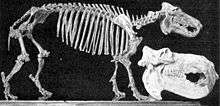
The even-toed ungulates are ungulates whose weight is borne about equally by the third and fourth toes, rather than mostly or entirely by the third as in perissodactyls. There are about 220 noncetacean artiodactyl species, including many that are of great economic importance to humans. Madagascar's only native artiodactyls are the extinct Malagasy hippos, which are believed to have descended from ancestors that managed to cross the Mozambique Channel from Africa in the late Quaternary, perhaps by swimming.[8] Two or three hippo colonization events may have occurred. H. lemerlei is thought to be a dwarfed form of Africa's H. amphibius, while H. laloumena was larger. C. madagascariensis may be more closely related to the African pygmy hippopotamus, C. liberiensis (the generic assignment of both pygmy forms has been in flux). Skeletal features indicate that Malagasy hippos were better adapted for running than African hippos. H. lemerlei remains have been found in the rivers and lakes of western Madagascar, suggesting a semiaquatic lifestyle similar to that of H. amphibious, while many C. madagascariensis remains have found in Madagascar's forested highlands, indicating a more terrestrial lifestyle.
- Family: Hippopotamidae (hippopotamuses)
- Genus: Choeropsis
- Malagasy pygmy hippopotamus Choeropsis madagascariensis EX (PH)
- Genus: Hippopotamus
- Lesser Malagasy hippopotamus Hippopotamus laloumena EX (PH)
- Malagasy dwarf hippopotamus Hippopotamus lemerlei EX (PH)
- Genus: Choeropsis
Infraorder: Cetacea (whales, dolphins and porpoises)
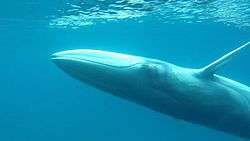
.jpg)
The infraorder Cetacea includes whales, dolphins and porpoises. They are the mammals most fully adapted to aquatic life with a spindle-shaped nearly hairless body, protected by a thick layer of blubber, and forelimbs and tail modified to provide propulsion underwater. Their closest extant relatives are the hippos, which are artiodactyls, from which cetaceans descended; cetaceans are thus also artiodactyls.
- Parvorder: Mysticeti
- Family: Balaenopteridae
- Subfamily: Balaenopterinae
- Genus: Balaenoptera
- Common minke whale Balaenoptera acutorostrata LC
- Antarctic minke whale Balaenoptera bonaerensis DD
- Southern sei whale Balaenoptera borealis schlegelii EN
- Bryde's whale Balaenoptera edeni DD
- Pygmy blue whale Balaenoptera musculus brevicauda DD
- Southern blue whale Balaenoptera musculus intermedia EN
- Omura's whale Balaenoptera omurai DD (among the most common rorquals of NW Madagascar[19])
- Southern fin whale Balaenoptera physalus quoyi EN
- Genus: Balaenoptera
- Subfamily: Megapterinae
- Genus: Megaptera
- Humpback whale Megaptera novaeangliae LC
- Genus: Megaptera
- Subfamily: Balaenopterinae
- Family: Cetotheriidae
- Subfamily: Neobalaeninae
- Genus: Caperea
- Pygmy right whale Caperea marginata DD[20][21]
- Genus: Caperea
- Subfamily: Neobalaeninae
- Family: Balaenidae
- Genus: Eubalaena
- Southern right whale Eubalaena australis LC (still rare in Madagascar)
- Genus: Eubalaena
- Family: Balaenopteridae
- Parvorder: Odontoceti
- Family: Physeteridae
- Genus: Physeter
- Sperm whale Physeter macrocephalus VU
- Genus: Physeter
- Family: Kogiidae
- Genus: Kogia
- Pygmy sperm whale Kogia breviceps DD
- Dwarf sperm whale Kogia sima DD
- Genus: Kogia
- Family: Ziphidae
- Genus: Indopacetus
- Tropical bottlenose whale Indopacetus pacificus DD
- Genus: Ziphius
- Cuvier's beaked whale Ziphius cavirostris DD
- Subfamily: Hyperoodontinae
- Genus: Mesoplodon
- Blainville's beaked whale Mesoplodon densirostris DD
- Gray's beaked whale Mesoplodon grayi DD
- Hector's beaked whale Mesoplodon hectori DD
- Layard's beaked whale Mesoplodon layardii DD
- True's beaked whale Mesoplodon mirus DD
- Genus: Mesoplodon
- Genus: Indopacetus
- Superfamily: Delphinoidea
- Family: Delphinidae (marine dolphins)
- Genus: Steno
- Rough-toothed dolphin Steno bredanensis LC
- Genus: Grampus
- Risso's dolphin Grampus griseus DD
- Genus: Globicephala
- Short-finned pilot whale Globicephala macrorhynchus DD
- Genus: Sousa
- Indian humpback dolphin Sousa plumbea NT
- Genus: Tursiops
- Indo-Pacific bottlenose dolphin Tursiops aduncus DD
- Common bottlenose dolphin Tursiops truncatus LC
- Genus: Stenella
- Pantropical spotted dolphin Stenella attenuata LC
- Striped dolphin Stenella coeruleoalba LC
- Spinner dolphin Stenella longirostris DD
- Genus: Delphinus
- Long-beaked common dolphin Delphinus capensis DD
- Genus: Lagenodelphis
- Fraser's dolphin Lagenodelphis hosei DD
- Genus: Peponocephala
- Melon-headed whale Peponocephala electra DD
- Genus: Pseudorca
- False killer whale Pseudorca crassidens DD
- Genus: Feresa
- Pygmy killer whale Feresa attenuata DD
- Genus: Orcinus
- Orca Orcinus orca DD
- Genus: Steno
- Family: Delphinidae (marine dolphins)
- Family: Physeteridae
Animals known of from Malagasy native tradition
See also
- Fauna of Madagascar
- Wildlife of Madagascar
- Mesozoic mammals of Madagascar
- List of regional mammals lists
- List of prehistoric mammals
- Mammal classification
- New mammal species
Notes
- ↑ This list is derived from the IUCN Red List, which includes extant mammal species as well as four recently extinct species known from subfossil remains. To these have been added other species believed to have died out following the arrival of humans, as well as a few species known from Holocene remains whose extinction dates are poorly constrained. The taxonomy and naming of the individual species is based on those used in existing Wikipedia articles, supplemented by the common names and taxonomy from the IUCN, Smithsonian Institution, or University of Michigan where no Wikipedia article was available.
- ↑ The tailless tenrec,[1] the common brown and mongoose lemurs[2][3] and the Madagascan pygmy shrew[4] are also present on the Comoros; all are thought to have been introduced.[5] The Madagascan pygmy shrew may also be present on Socotra, and some authorities have viewed it as conspecific with the widespread Etruscan shrew.[6]
- ↑ The shrew genus Suncus is widespread in Africa and Eurasia.
- ↑ The tenrec family, Tenrecidae, and the rodent family Nesomyidae are also present in Africa; the shrew family, Soricidae, is cosmopolitan. Madagascar has far more species of Tenrecidae and nearly as many of Nesomyidae as does Africa.
- ↑ Mittermeier et al. 2006, pp. 23–26[3]
References
- ↑ Afrotheria Specialist Group (Tenrec Section); Vololomboahangy, R. & Goodman, S. (2008). "Tenrec ecaudatus". IUCN Red List of Threatened Species. Version 2014.1. International Union for Conservation of Nature. Retrieved 2014-06-21.
- ↑ Pastorini, J.; Thalmann, U.; Martin, R. D. (2003). "A molecular approach to comparative phylogeography of extant Malagasy lemurs" (PDF). Proceedings of the National Academy of Sciences. 100 (10): 5879–5884. Bibcode:2003PNAS..100.5879P. doi:10.1073/pnas.1031673100.
- 1 2 Mittermeier, R.A.; Konstant, W.R.; Hawkins, F.; Louis, E.E.; Langrand, O.; Ratsimbazafy, J.; Rasoloarison, R.; Ganzhorn, J.U.; Rajaobelina, S.; Tattersall, I.; Meyers, D.M. (2006). Lemurs of Madagascar. Illustrated by S.D. Nash (2nd ed.). Conservation International. pp. 23–26 and 272–274. ISBN 1-881173-88-7. OCLC 65171602.
- ↑ Desvars, A.; Naze, F.; Vourc'h, G.; Cardinale, E.; Picardeau, M.; Michault, A.; Bourhy, P. (July 2012). "Similarities in Leptospira Serogroup and Species Distribution in Animals and Humans in the Indian Ocean Island of Mayotte". American Journal of Tropical Medicine and Hygiene. 87 (1): 134–140. doi:10.4269/ajtmh.2012.12-0102. PMC 3391038
 . PMID 22764304.
. PMID 22764304. - ↑ Weyeneth, N.; Goodman, S. M.; Appleton, B.; Wood, R.; Ruedi, M. (2011-03-28). "Wings or winds: Inferring bat migration in a stepping-stone archipelago". Journal of Evolutionary Biology. 24 (6): 1298–1306. doi:10.1111/j.1420-9101.2011.02262.x. PMID 21443643.
- ↑ Hutterer, R. (2005). "Suncus madagascariensis". In Wilson, D.E.; Reeder, D.M. Mammal Species of the World: A Taxonomic and Geographic Reference (3rd ed.). Johns Hopkins University Press. p. 259. ISBN 978-0-8018-8221-0. OCLC 62265494.
- 1 2 3 Kinver, M. (2010-01-20). "Mammals 'floated to Madagascar'". BBC News web site. BBC. Retrieved 2010-01-20.
- 1 2 3 4 5 Ali, J. R.; Huber, M. (2010-01-20). "Mammalian biodiversity on Madagascar controlled by ocean currents". Nature. Nature Publishing Group. 463 (4 Feb. 2010): 653–656. Bibcode:2010Natur.463..653A. doi:10.1038/nature08706. PMID 20090678. Retrieved 2010-01-20.
- ↑ Horovitz, I. S. (December 2004). "Eutherian Mammal Systematics and the Origins of South American Ungulates As Based on Postcranial Osteology". Bulletin of Carnegie Museum of Natural History. 36: 63–79. doi:10.2992/0145-9058(2004)36[63:EMSATO]2.0.CO;2.
- 1 2 MacPhee, R. D. E. (1994). "Morphology, adaptations, and relationships of Plesiorycteropus, and a diagnosis of a new order of eutherian mammals". Bulletin of the American Museum of Natural History. American Museum of Natural History. 220: 1–214. Retrieved 2014-06-25.
- ↑ Buckley, M. (2013). "A Molecular Phylogeny of Plesiorycteropus Reassigns the Extinct Mammalian Order 'Bibymalagasia'". PLoS ONE. 8 (3): e59614. doi:10.1371/journal.pone.0059614. PMC 3608660
 . PMID 23555726.
. PMID 23555726. - ↑ Burney, D. A.; Burney, L. P.; Godfrey, L. R.; Jungers, W. L.; Goodman, S. M.; Wright, H. T.; Jull, A. J. T. (July 2004). "A chronology for late prehistoric Madagascar". Journal of Human Evolution. 47 (1–2): 25–63. doi:10.1016/j.jhevol.2004.05.005. PMID 15288523.
- ↑ Mittermeier, R., Ganzhorn, J., Konstant, W., Glander, K., Tattersall, I., Groves, C., Rylands, A., Hapke, A., Ratsimbazafy, J., Mayor, M., Louis, E., Rumpler, Y., Schwitzer, C. & Rasoloarison, R. (December 2008). "Lemur Diversity in Madagascar". International Journal of Primatology. 29 (6): 1607–1656. doi:10.1007/s10764-008-9317-y.
- ↑ Horvath, J.; et al. (2008). "Development and application of a phylogenomic toolkit: Resolving the evolutionary history of Madagascar's lemurs" (PDF). Genome Research. 18 (3): 489–99. doi:10.1101/gr.7265208. PMC 2259113
 . PMID 18245770. Retrieved 2008-08-22.
. PMID 18245770. Retrieved 2008-08-22. - ↑ Garbutt, N. (2007). Mammals of Madagascar, A Complete Guide. A&C Black Publishers. pp. 85–86. ISBN 978-0-300-12550-4.
- ↑ Mittermeier, R. A.; Rylands, A. B.; Konstant, W. R. (1999). "Primates of the world: An introduction". In Nowak, R. M. Walker's Mammals of the World (6th ed.). Johns Hopkins University Press. pp. 4–6. ISBN 978-0-8018-6251-9.
- ↑ Cawthon Lang KA. 2005 July 18. Primate Factsheets: Owl monkey (Aotus) Taxonomy, Morphology, & Ecology. Accessed 2015 March 26.
- ↑ Goodman, S. M.; Helgen, K. M. (2010-02-25). "Species limits and distribution of the Malagasy carnivoran genus Eupleres (Family Eupleridae)". Mammalia. 74 (2): 177–185. doi:10.1515/mamm.2010.018.
- ↑ Cerchio S.; Andrianantenaina B.; Lindsay A.; Rekdahl M.; Andrianarivelo N.; Rasoloarijao T. (2015). "Omura's whales (Balaenoptera omurai) off northwest Madagascar: ecology, behaviour and conservation needs" (pdf). The Royal Society Publishing. The Royal Society Open Science. Retrieved 2015-10-24.
- ↑ Madagascar Country Profile - Project GloBAL Home. Duke University Retrieved on 13 June 2014
- ↑ Sea Alarm Foundation. 2010 Madagascar - Country Wildlife Response Profiles - A Summary of oiled wildlife response arrangements and resources worldwide. Retrieved on 13 June 2014
- "Mammal Species of the World". Smithsonian National Museum of Natural History. 2005. Retrieved 22 May 2007.
- "Animal Diversity Web". University of Michigan Museum of Zoology. 1995–2006. Retrieved 22 May 2007.


.jpg)


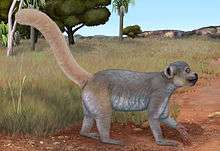


_2b.jpg)
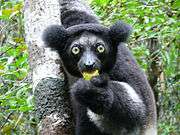




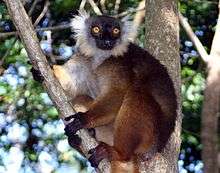

.jpg)








.jpg)



